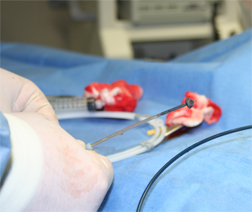PDA in Dogs: Patent Ductus Arteriosus
Patent Ductus Arteriosus (PDA) is a form of congenital heart disease. Animals with this condition retain a vascular connection between the aorta and pulmonary artery, two large vessels leaving the heart. In unaffected animals, these vessels are only connected before birth. The connection normally closes down within a week after birth. In animals with PDA, the connection remains open permanently.

An Amplatz Duct Occluder, placed by means of a catheter inserted through skin incisions in the leg or neck.
In animals with PDA, blood leaving the heart reaches the connection between the two vessels and flows through the opening. This creates an abnormal flow pattern. Due to this abnormal flow, a special type of heart sound called a continuous heart murmur can be heard by a veterinarian.
Two types of flow patterns can exist, either left to right or right to left. In a left to right PDA, the blood flows from the aorta into the pulmonary artery and in a right to left PDA, that pattern is reversed.
In a left to right PDA, the abnormal flow changes the amount of work the heart has to do to pump blood to the body. Over time, the increased workload causes changes in the structure of the heart, and can result in congestive heart failure. Therefore, animals with left to right PDA may have a significantly shorter life span than unaffected animals. Uncorrected left to right PDA usually causes heart failure before 1 year of age.
The treatment of choice for animals with left to right PDA is closure of the abnormal connection. Various techniques may be utilized. The PDA may be closed by ligating the connection surgically (this requires open chest surgery) or devices that block the PDA may be placed by means of catheters that are inserted through skin incisions in the leg or neck. When successful, these procedures cure the condition. Unfortunately, right to left PDA cannot be corrected surgically, but some of the changes that result can be managed medically for a period of time.